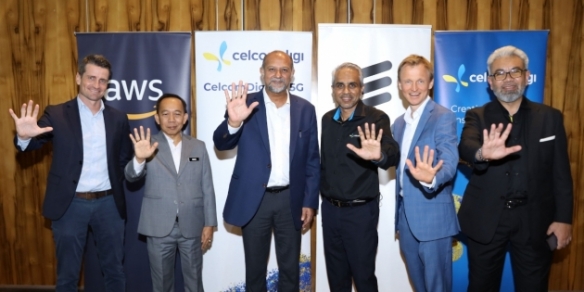Telco Deep Dive 2018: Plan for 5G concurrently with ASO suggests MyTV
By Karamjit Singh January 7, 2019
- MyTV confident of meeting ASO deadline, feels govt need not wait to plan for 5G
- DTT to hit 95% of households, DTH satellite will be used for remaining 5% users

IT WOULD be all too easy to moan and groan about how political circumstances and the technology gods have conspired against MyTV Broadcasting Sdn Bhd to make its once profitable digital terrestrial television (DTT) contract “unbankable” in the words of its chief executive officer, Michael Chan.
Read Also: DIGITAL TERRESTRIAL TV TENDER: SO WHAT’S UP, REALLY?
But Chan is also candid enough to admit that some internal challenges on MYTV’s side contributed to the overall delay in the company rolling out Malaysia’s DTT service. Chan talks about a triple whammy to MyTV.
 “My costs ballooned due to delays, both from internal and external reasons. As a result, we could not get the project financed and are doing it internally.” The second big hit came when the new Mandatory Access on Standard Pricing (MASP) came into effect in early 2018. Because of that, MyTV cannot charge broadcasters what it had planned to and is now capped at US$1.45 million (RM6 million) for SD (Standard Definition) and US$1.7 million (RM7 million) for HD (High Definition) channels. The third hit came from the Malaysian government not honouring the agreement MyTV had with the previous government in providing 2.2 million set-top boxes (STBs) to the market. [Malaysia saw a change in government in May 2018 after its 14th General Elections].
“My costs ballooned due to delays, both from internal and external reasons. As a result, we could not get the project financed and are doing it internally.” The second big hit came when the new Mandatory Access on Standard Pricing (MASP) came into effect in early 2018. Because of that, MyTV cannot charge broadcasters what it had planned to and is now capped at US$1.45 million (RM6 million) for SD (Standard Definition) and US$1.7 million (RM7 million) for HD (High Definition) channels. The third hit came from the Malaysian government not honouring the agreement MyTV had with the previous government in providing 2.2 million set-top boxes (STBs) to the market. [Malaysia saw a change in government in May 2018 after its 14th General Elections].
“We accepted their decision but as a result, we will now deliver two million STBs to our broadcasters and not 4.2 million,” says Chan (pic, right).
In return however, he says MyTV has renegotiated its contract with the government and its original 15-year contract has been extended by another 15 years. And, it now has to deliver DTT to 95% of households versus the original 98%. This allows it to save money as it will be using direct-to-home (DTH) satellites to meet the final 5% coverage. In late November it signed a US$1 million deal with remote communication and IT solutions provider, Speedcast, for this purpose, says Chan.
The extension offers some good news for MyTV but Chan is not getting too excited, “as you never know how technology and user behavior will change in the future.” MyTV has already experience being bitten by technology developments, specifically with the strong emergence of OTT video in the form of Netflix and iflix and other non-English OTT video apps that have drawn audiences away from traditional TV.
The strong shift of adex (advertising expenditure) from TV to digital media platforms is also another hit that they did not see coming when bidding for DTT in 2013. “Advertising was going to be one of our revenue streams besides the yearly channel fees from broadcasters, but clearly that will not be the case now, especially with global tech players capturing so much of adex today,” says Chan.
Read also: MYTV’S WOES, A CASE OF GOOD MONEY CHASING AFTER BAD MONEY?
Freeing up 700 MHz spectrum for 5G
For MyTV and Chan, the immediate priority is to meet its delayed ASO commitment so that the 700MHz spectrum can be handed back to the government. As is common throughout the world, this spectrum is being used for free-to-air TV broadcasts.
Yet today, that 700MHz band is seen as a critical chunk of spectrum identified for 5G use that will allow a country to accelerate its adoption towards a Digital Economy. The European Union, as early as 2016 had already reached political agreement on an EU-wide approach for the use of the ultra-high frequency (UHF) band 700 MHz band (694-790 MHz) which will be assigned to mobile operators and made available for wireless broadband use by end-June 2020.
This spectrum band is seen by the telco industry as ideal for providing high-quality internet to indoor users in cities and to provide cost efficient coverage for remote villages. A plethora of digital services, such as connected cars, remote health care, IoT, Virtual Reality and video streaming are expected to run smoothly on 5G networks.
For Malaysia, from initially being in mid-2018 (though the Malaysian government never actually came out with a clear date for the ASO) the new and final date for the ASO is end-March 2019 – less than three months away.
While the government is behind in its preparations for 5G, the telcos have been making their own preparations, holding small pilots, while waiting for official engagement with the government on 5G. That engagement officially started in November 2018 with the formation by the Malaysian Communications and Multimedia Commission (MCMC) of the 5G Test Bed Working Group to coordinate 5G trials in Putrajaya and Cyberjaya from November 2018 until Oct 31, 2019.
Aware of the 5G stakes, Chan suggests that the government start engaging with the telcos over its plans for 5G concurrently while MyTV is racing to meet its ASO deadline. “I think they can start those discussions now because by the time they issue any tender process we would have completed our ASO and met our promise of restacking the 700 band six-months after the ASO so that we can hand it back to the government,” he says. “It can be done,” he says confidently.
MyTV is already giving MCMC daily reports on how many STBs it is getting into the hands of users. A team of close to 800 people, consisting of about 80 from MyTV and 700 from Altel Communications Sdn Bhd, have been working feverishly over the past six months to deliver STBs. Both are affiliate companies under Altel Holdings which itself is under the Al-Bukhary Group.
“We have been averaging 10,000 units a day in December and from January to March we can deliver between 40,000 to 80,000 STBs a day,” says Chan. MyTV has 1.3 million STBs to distribute by March and Chan reiterates that, “we will deliver on our commitment to the government” while acknowledging the unwavering support of Syed Mokhtar Al-Bukhary, the founder of the Al-Bukhary Group who has committed to investing a further US$72.8 million (RM300 million) to ensure the ASO is met. This is in addition to the more than US$124 million (RM511 million) he has invested already.
Fortunately for MyTV, the logistical challenge of delivering 1.3 million STBs by end March is being met thanks to close cooperation from PosMalaysia Bhd, also a company within the Al-Bukhary group. In fact, the new chief executive of Pos Malaysia is Syed Najib, who was the former CEO of Altel.
Pos Malaysia’s strong logistical network comes in especially handy in delivering STBs to users in Sabah and Sarawak, Chan acknowledges. A factory in Shanghai, China that is manufacturing the STBs has cancelled its usual long break for the Chinese New Year (CNY) to help MyTV meet its deadline. “We are paying them extra for this and they are only closing for a few days instead of the usual one-month shutdown during CNY,” Chan explains.
Revenue-wise, MyTV is projecting RM150 million a year, its most optimistic projection. But even with this, its payback period will stretch to beyond 15 years, which is why it asked for an extension to its concession period.
But reaching this revenue figure will be tough as it is unclear how many parties in the market are aiming to own their own content channel that will reach an audience of two million households in an era where consumers can purchase special STBs that afford them content from all over the world and where they can download a plethora of OTT apps direct to their smart TVs that give them access to content of their choice.
Meanwhile, the only confirmed customers for MyTV’s DTT service will be the government TV stations and perhaps one channel from the Media Prima Group.
Acknowledging this, Chan says, “Our worst case scenario is earning yearly revenue of below RM100 million which will mean that shareholders have to keep pumping in money.” That will not be a pleasant prospect for Chan or the Al-Bukhary group but it could well be the most likely scenario unless Chan manages to pull a rabbit from the hat.
Related Stories :


